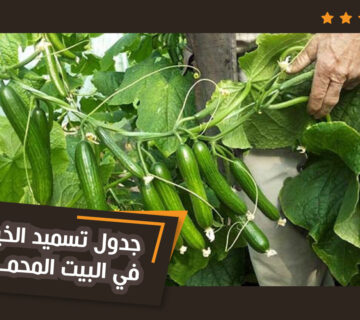There are many plants that greenhouse allow to produce throughout the year, through their ability to provide cooling systems and heating appropriate for the growth of these plants, including ornamental plants>. /strong>, but there is an annual calendar that must be adhered to, in addition to continuous follow-up and recording of observations, to ensure optimal production.
قائمة المحتوى
Annual calendar of ornamental plants
If ornamental plants are grown inside greenhouses, a specific annual calendar must be followed, commensurate with the nature of those plants, and the climatic and environmental conditions suitable for their growth.. Here is the appropriate agricultural calendar for ornamental plants:</ p>
Annual calendar of planting roses in home gardens
January
- The greenhouse is being heated well.
- It is also taken into account to provide the house with artificial night lighting, especially for long-day plants (plants that need long periods of light to grow).
- The atmosphere must be maintained dry, to avoid the emergence of any fungal diseases, especially powdery mildew.
- The flowering plants are irrigated abundantly, and other plants in small quantities.
- It is also necessary to work on introducing bulbous plants into the greenhouse, and planting cuttings of carnations, gypsophila and rose.
February
- Ventilation is adjusted as needed Greenhouse.
- Plants continue to be provided with artificial lighting.
- Summer annuals are also placed in the breeding grounds.
- The grafting process begins with the plants being rotated (by changing the soil and transferring them to larger pots).
- The process of introducing flowering bulbous plants into the greenhouse continues.
March
- The amount of watering is usually increased during this month.
- Ventilation of the house during sunny days, and maintaining an acceptable humidity.
- In addition to monitoring all diseases and pests; Including aphids, thrips and red spiders.
Nissan
- The heating system continues to operate inside the greenhouse, and if any increase in temperature occurs; Aeration and irrigation are used.
- The flowering plants are placed in the culture medium.
- The seedlings, obtained during planting seeds during the spring, are also transferred to their place in the field.
- In addition to starting pruning the rose bushes.
May
- In this month, plants are watered abundantly.
- Provide the necessary ventilation and increase humidity.
- All plants are fertilized during growth periods.
- Control all harmful insects and pests.
- Begin planting carnations as a cut flower crop.
- He also took the mind of the flower of the Birth Star; In preparation for flowering by December.
June
- The heating systems inside the greenhouse are often turned off during the month of June.
- Start by ventilating and humidifying the greenhouse from the inside, and shading it from the outside.
- Water the plants twice daily as needed.
- You can also start with a short day treatment regimen, to help the short day plants grow.
- Begin planting some plants, in preparation for their flowering during the winter and fall seasons.
July
- Continue to use cooling and ventilation systems, and apply short day treatment.
- Represents the last month in which it is possible to plant carnations for the purpose of producing cut flowers.
- The rate of irrigation (particularly sprinkler irrigation) of the bird of paradise plant is increased.
August
- Start monitoring temperature at night.
- Planting daffodils and tulips until they bloom by winter and spring.
- start with liquid fertilizer; For fertilizing flowering plants.
- Necessary repairs to the greenhouse should be carried out, such as repainting it again.
September
- Watering and humidification is usually reduced in September; due to low temperatures.
- Gradually reduce shading.
- And start heating systems if required.
- Expand bulbs and electric flowers over the growth beds, to provide long-day treatment for the plantTat you need.
Learn about the agricultural calendar for other greenhouse plants
October
- Full heating system operation.
- Using thermostats to maintain appropriate temperatures for each type of cultivated plant.
- Ventilate the greenhouse during warm days.
- In addition to permanently removing shading, and reducing watering.
- Plant all remaining bulbous plants in pots.
- Put fertilizer for flowering plants.
- The sterilization and control of snails should also begin.
November
- The minimum temperature is maintained throughout the night.
- Water the flower crops in small quantities.
- Replant winter plants in larger pots.
- Also, introducing some winter bulbous plants to the greenhouse.
- Cultivation of Lilium bulbs.
December
- Heating a well-protected house.
- Raise the temperature of the regulator, in case any frost is expected.
- Resort for ventilation when necessary.
- Remove fallen leaves and dirt from the greenhouse.
- Watch out for fungal diseases, including gray mold, rust and mildew, as they present a significant risk to greenhouse plants.
And ornamental plants are an important commercial product, as they are widely used by the public for what they add of an attractive appearance, and are even included in the preparation of sports stadiums, and are placed on roadsides and inside gardens..etc, and because homes Of course, the reserve allows for abundant production compared to traditional cultivation, as it increases the material return of these plants.

 then 'Add to home screen'
then 'Add to home screen' then 'Add to home screen'
then 'Add to home screen'







لا يوجد تعليقات